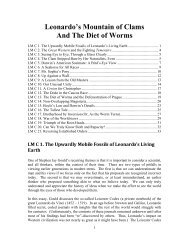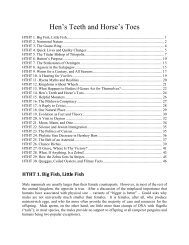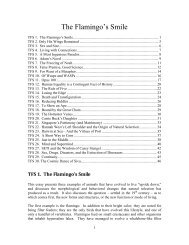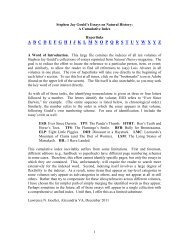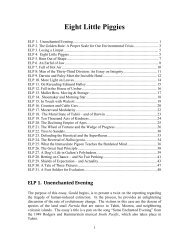Edgar Allan Poe, it turns out, wrote a book on nature. More accurately, his nameappeared as the sole author on an inexpensive text on mollusks, although others did mostof the work. This book, as it happens, was the only work he published that was reprintedduring his lifetime. By this standard, it may be considered to be his most (and perhapsonly) successful publication; hence the essay’s title. A friend of Poe’s named ThomasWyatt, an actual expert on mollusks, produced large parts of it; other parts were copiedand sometimes blatantly plagiarized from other sources. Poe’s biographers, Gould tellsus, uniformly describe it as shameless hackwork. Gould, who acquired a copy, agreesthat Poe was no naturalist and did commit plagiarism, but states that the finished productis actually not that bad. <strong>In</strong> fact, he continues, it has a key feature that is standard practicetoday but was a true innovation in its time.The text in question is entitled The Conchologist’s First Book, and was first published in1839. Gould researched the story behind it, with the following results. <strong>In</strong> 1838, aProfessor Thomas Wyatt wrote an expensive book on mollusk shells (“sea shells”), withbeautiful color plates. It did not sell well, and Wyatt was looking to produce a lessexpensive version with black and white plates (Gould tells us why later). The publisherwas not interested in further eroding interest in the expensive version, and declined. SoWyatt, who new Poe through some unknown channel, paid him a lump sum of $50 tohelp him produce a new book. Poe wrote the preface and the introduction. Next cametwelve plates of mollusk shells, all of which were directly stolen from a British bookcalled The Conchologist’s Text-Book by Captain Thomas Brown – as was a good part ofPoe’s introduction. The next section is a ten-page discussion of the parts of shells, andthis was also plagiarized from Brown with some minor alterations. The main body of thework then follows: 120 pages of genus-by-genus description of each animal and its shell,and a list of all species within each genus. This section follows the structure of Wyatt’smore expensive book, with the descriptions of the soft parts from the great Frenchnaturalist Cuvier [HTHT 7], and those of the shells from Wyatt’s book. Captain Brown’swork was easy to plagiarize because it was published in Scotland, and there were noenforceable international copyright laws at that time. Poe and Wyatt may or may nothave thought they were behaving immorally, but some others certainly did. <strong>In</strong> lateryears, Poe expended some effort in a lawsuit against a journal that identified thisplagiarism.All of the preceding is true, but it is insufficient to explain what actually motivated theauthors. Wyatt, it turns out, made a living on the lecture circuit, which at that time wasany men’s lodge, women’s garden club, or book circle in any town that would have him.Speaking fees were low, and Wyatt would have made a significant fraction of his incomefrom the sale of any printed materials that he brought with him – hence the need for aninexpensive book on his chosen subject. He could not use the plates from his own(expensive) book, as his publisher had denied him permission; but Captain Brown’s bookwas readily available for “borrowing” plates and text. Why did Wyatt turn to Poe forassistance? Poe, it turns out, was fluent in French, the result of living in England for fiveyears as a child and classically educated there. This allowed him to translate Cuvier’swork on the soft parts of the mollusk, which Gould points out leads to the key innovationof this little book. “Conchology” is only the study of the shells of mollusks, which is20
how Linnaeus himself classified them. Wyatt’s innovation, noted by Poe in the prefaceand introduction (and apparently missed by his biographers), is to describe the soft partsnext to the hard parts. Thus, this is likely the first book on malacology (the study ofmollusks) rather than pure conchology, although both terms are used in the book. NeitherCaptain Brown’s book nor Wyatt’s own expensive publication was structured in this way.Although the process by which the book was created was unsavory, and the integrationbetween the animal and its shell rather minimal, Gould concludes that the result isdefinitely not “hack work.”Why did Wyatt not include his own name on the book? Perhaps, as Poe himself latersuggested, it was an issue of name recognition; perhaps he knew plagiarism when he sawit, and wanted to protect his reputation; or perhaps it was just easier to tout the quality ofa publication that did not bear his own name (no doubt he kept all proceeds for himself).The true reason or reasons appear to be lost to history.DIH 15. The <strong>In</strong>visible WomanWomen have historically faced the same types of discrimination in the sciences as theyhave in all other aspects of European and American life. Prior to the 1970s, Gould tellsus, there were very few women scientists or professors in any field, including his own. <strong>In</strong>addition to the absence of official positions and salaries, they very rarely published,rendering even the most creative women metaphorically invisible.One exception to this general rule during the Victorian era in England was a saccharineform of natural history book aimed at women and/or children (there appears to be littledifference in style). All such books in this genre followed a certain format. One keyelement was the expression of the subject as a sign of God’s goodness, his attention todetail, and his constant presence. Also implied was that all organisms were created eitherdirectly or indirectly for the benefit of God’s greatest creation, Man. A third recurringtheme in this culturally conservative era was the insistence that every creature (and, byimplication, every person) had a place in the big scheme of things, and that it would bewrong to advocate any changes – including social changes – from God’s plan.Gould became interested in this genre as a historian of science, and wanted to gain insightinto what these women were like. As an avid procurer of antiquarian books, he pickedone called The Conchologist’s Companion, 1834 edition, by Mary Roberts. He had notheard of the book or its author, but the subject was in his area of professional expertise.Not surprisingly, Gould learned nothing in the way of science from it, and he was mostlysaddened by the thought of women burning with the need to learn and create beinglimited to writing such drivel.Gould does, however, make a connection with one of the great essays by Edmund Burke:Philosophical <strong>In</strong>quiry into the Origin of Our Ideas of the Sublime and Beautiful, firstpublished in 1756. (<strong>In</strong> an extended footnote, he states that he had not read Burke’s essayall the way through until preparing for this essay. It is forced opportunities such as this,he states, that keep him writing month after month.) Burke argues that the sublime is all21
- Page 4 and 5: cloud (“nebula”) of gas and dus
- Page 6 and 7: goodness, and is both intelligent a
- Page 9: The second news story involves the
- Page 12 and 13: key ways. Prior to 1994, no fossil
- Page 14: DIH 11. Lucy on the Earth in Stasis
- Page 17: directly resulted in a mass extinct
- Page 22 and 23: things male, while the beautiful is
- Page 24 and 25: interest, until the entrepreneur of
- Page 26 and 27: essay is that scientists, for all t
- Page 28 and 29: DIH 23. The Smoking Gun of Eugenics
- Page 30 and 31: half-Jewish meant Jewish, while qua
- Page 32 and 33: Darwin’s theory, like Adam Smith
- Page 34 and 35: What might a better definition of t
- Page 36 and 37: type of soil, amount of rain, and s
- Page 38 and 39: Case Four, in Gould’s words, is
- Page 40 and 41: multiplying his findings by the num
- Page 42 and 43: other departments, something that r
- Page 44 and 45: Linnaeus, Gould states, did not sim
- Page 46: greatly prefers these metaphors, on




